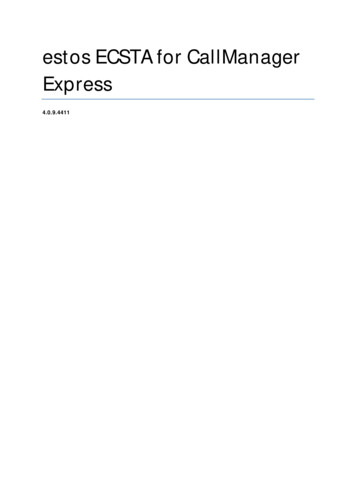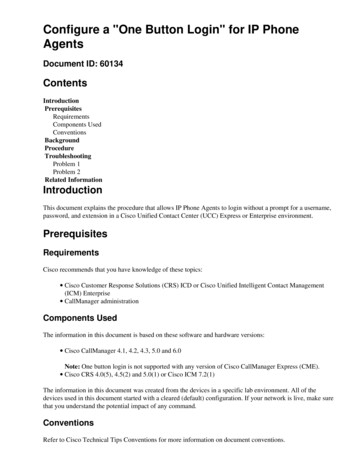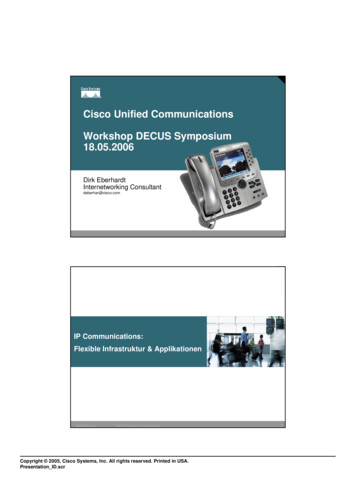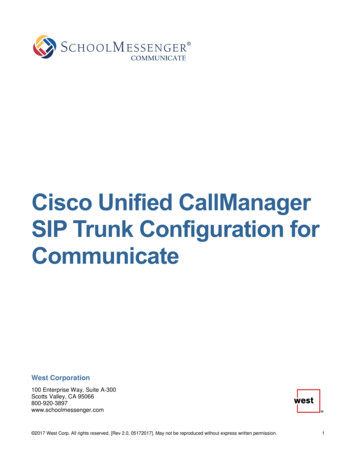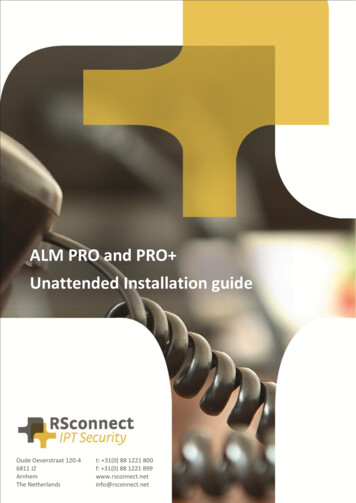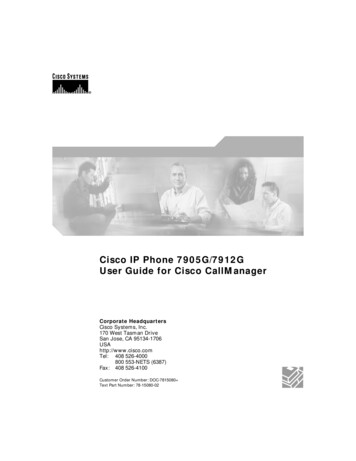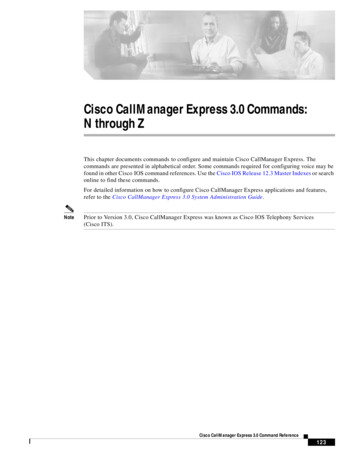
Transcription
Cisco CallManager Express 3.0 Commands:N through ZThis chapter documents commands to configure and maintain Cisco CallManager Express. Thecommands are presented in alphabetical order. Some commands required for configuring voice may befound in other Cisco IOS command references. Use the Cisco IOS Release 12.3 Master Indexes or searchonline to find these commands.For detailed information on how to configure Cisco CallManager Express applications and features,refer to the Cisco CallManager Express 3.0 System Administration Guide.NotePrior to Version 3.0, Cisco CallManager Express was known as Cisco IOS Telephony Services(Cisco ITS).Cisco CallManager Express 3.0 Command Reference123
Cisco CallManager Express 3.0 Commands: N through Zname (ephone-dn)name (ephone-dn)To associate a name with a Cisco CallManager Express (Cisco CME) extension (ephone-dn), use thename command in ephone-dn configuration mode. To disassociate a name from an extension, use the noform of this command.name nameno nameSyntax DescriptionnameDefaultsNo default behavior or valuesCommand ModesEphone-dn configurationCommand HistoryCisco IOS ReleaseCisco CME VersionModification12.1(5)YD1.0This command was introduced on the following platforms:Cisco 2600 series, Cisco 3600 series, and Cisco IAD2420series.12.2(2)XT2.0This command was implemented on the Cisco 1750 andCisco 1751.12.2(8)T2.0This command was integrated into Cisco IOS Release12.2(8)T and implemented on the following platforms:Cisco 2600XM, Cisco 2691, Cisco 3725, and Cisco 3745.Name of the person associated with this extension (ephone-dn). Name mustfollow the order specified in the directory (telephony-service) command,either first-name-first or last-name-first.Usage GuidelinesThe username argument is used to provide caller ID for calls originating from a Cisco CME extension.This command is also used to generate directory information for the local directory that is accessed fromthe Directories button on a Cisco IP phone.ExamplesThe following example configures the username John Smith with the pattern first-name-first:Router(config)# ephone-dn 1Router(config-ephone-dn) name John SmithThe following example configures the username Jane Smith with the pattern last-name-first:Router(config)# ephone-dn 1Router(config-ephone-dn) name Smith, JaneCisco CallManager Express 3.0 Command Reference124
Cisco CallManager Express 3.0 Commands: N through Zname (ephone-dn)Related ice)Defines the name order for the local directory of Cisco IP phone users.ephone-dnEnters ephone-dn configuration mode.Cisco CallManager Express 3.0 Command Reference125
Cisco CallManager Express 3.0 Commands: N through Znetwork-localenetwork-localeTo select a code for a geographically-specific set of tones and cadences on the Cisco IP Phone 7940 andCisco IP Phone 7960, use the network-locale command in telephony-service configuration mode. Todisable selection of a code, use the no form of this command.network-locale locale-codeno network-locale locale-codeSyntax Descriptionlocale-codeThe following ISO-3166 codes are valid entries: AT—Austria. CA—Canada. CH—Switzerland. DE—Germany. DK—Denmark. ES—Spain. FR—France. GB—United Kingdom. IT—Italy. NL—Netherlands. NO—Norway. PT—Portugal. RU—Russian Federation. SE—Sweden. US—United States (default).DefaultsThe default country code is US (United States).Command ModesTelephony-service configurationCommand HistoryCisco IOS ReleaseCisco CME VersionModification12.2(11)YT2.1This command was introduced.12.2(15)T2.1This command was integrated into Cisco IOS Release12.2(15)T.Cisco CallManager Express 3.0 Command Reference126
Cisco CallManager Express 3.0 Commands: N through Znetwork-localeUsage GuidelinesUse this command with Cisco IOS Telephony Services V2.1, Cisco CallManager Express 3.0, or a laterversion.The show telephony-service tftp-bindings command displays the locale-specific call-progress tonefiles that are accessible to IP phones using TFTP.ExamplesThe following example sets tones and cadences for France:Router(config)# telephony-serviceRouter(config-telephony-service)# network-locale FRRelated p-bindingsDisplays the current configuration files that are accessible to IP phones.telephony-serviceEnters telephony-service configuration mode.Cisco CallManager Express 3.0 Command Reference127
Cisco CallManager Express 3.0 Commands: N through Znight-service bell (ephone)night-service bell (ephone)To mark an IP phone to receive night-service bell notification when incoming calls are received onephone-dns that are marked for night service during night-service time periods, use the night-servicebell command in ephone configuration mode. To remove night-service notification capability from aphone, use the no form of this command.night-service bellno night-service bellSyntax DescriptionThis command has no arguments or keywords.DefaultsA phone is not marked for night-service bell notification.Command ModesEphone configurationCommand HistoryCisco IOS ReleaseCisco CME VersionModification12.2(15)ZJ3.0This command was introduced.12.3(4)T3.0This command was integrated into Cisco IOSRelease 12.3(4)T.Usage GuidelinesWhen an ephone-dn is marked for night-service treatment using the night-service bell (ephone-dn)command, incoming calls that ring during the night-service time period on that ephone-dn send an alertindication to all IP phones that are marked to receive night-service bell notification with this command.The alert notification is in the form of a splash ring (not associated with any of the individual lines onthe IP phone) and a visible display of the ephone-dn extension number. The phone user retrieves the callby pressing a PickUp or GPickUp soft key and dialing the appropriate digits.Night-service periods are defined using the night-service date and night-service day commands. Nightservice can be manually disabled or reenabled from a phone with ephone-dns in night-service mode ifthe night-service code command has been set.ExamplesThe following example designates the IP phone that is being configured as a phone that will receivenight-service bell notification when ephone-dns marked for night service receive incoming calls duringa night-service period:Router(config)# ephone 4Router(config-ephone)# night-service bellCisco CallManager Express 3.0 Command Reference128
Cisco CallManager Express 3.0 Commands: N through Znight-service bell (ephone)Related CommandsCommandDescriptionephoneEnters ephone configuration mode.night-service bell(ephone-dn)Marks an ephone-dn to send night-service bell notification to designated IPphones during night-service time periods.night-service codeDefines a code to disable or reenable night service on IP phones.night-service dateDefines a recurring time period associated with a month and date duringwhich night service is active.night-service dayDefines a recurring time period associated with a day of the week duringwhich night service is active.Cisco CallManager Express 3.0 Command Reference129
Cisco CallManager Express 3.0 Commands: N through Znight-service bell (ephone-dn)night-service bell (ephone-dn)To mark an ephone-dn for night-service treatment, use the night-service bell command in ephone-dnconfiguration mode. To remove the night-service treatment from the ephone-dn, use the no form of thiscommand.night-service bellno night-service bellSyntax DescriptionThis command has no arguments or keywords.DefaultsAn ephone-dn is not marked for night service.Command ModesEphone-dn configurationCommand HistoryCisco IOS ReleaseCisco CME VersionModification12.2(15)ZJ3.0This command was introduced.12.3(4)T3.0This command was integrated into Cisco IOSRelease 12.3(4)T.Usage GuidelinesWhen an ephone-dn is marked for night-service treatment using this command, incoming calls that ringduring the night-service time period on that ephone-dn send an alert indication to all IP phones that aremarked to receive night-service bell notification using the night-service bell (ephone) command. Thealert notification is in the form of a splash ring (not associated with any of the individual lines on the IPphone) and a visible display of the ephone-dn extension number. The phone user retrieves the call bypressing a PickUp or GPickUp soft key and dialing the appropriate digits.Night-service periods are defined using the night-service date and night-service day commands. Nightservice can be manually disabled or reenabled from a phone with ephone-dns in night-service mode ifthe night-service code command has been set.ExamplesThe following example marks an ephone-dn as a line that will ring on IP phones designated to receivenight-service bell notification when incoming calls are received on this ephone-dn during night-serviceperiods:Router(config)# ephone-dn 16Router(config-ephone-dn)# night-service bellCisco CallManager Express 3.0 Command Reference130
Cisco CallManager Express 3.0 Commands: N through Znight-service bell (ephone-dn)Related CommandsCommandDescriptionephone-dnEnters ephone-dn configuration mode.night-service bell(ephone)Marks an IP phone to receive night-service bell notification when incomingcalls are received on ephone-dns that are marked for night service duringnight-service time periods.night-service codeDefines a code to disable or reenable night service on IP phones.night-service dateDefines a recurring time period associated with a month and date duringwhich night service is active.night-service dayDefines a recurring time period associated with a day of the week duringwhich night service is active.Cisco CallManager Express 3.0 Command Reference131
Cisco CallManager Express 3.0 Commands: N through Znight-service codenight-service codeTo define a code to disable or reenable night service on IP phones, use the night-service code commandin telephony-service configuration mode. To remove the code, use the no form of this command.night-service code digit-stringno night-service code digit-stringSyntax Descriptiondigit-stringDefaultsNo code is defined.Command ModesTelephony-service configurationCommand HistoryCisco IOS ReleaseUsage GuidelinesDigit code that a user enters at an IP phone to disable or reenable nightservice on all ephone-dns that are marked for night service on that phone.The code must begin with an asterisk (*). The maximum number ofcharacters is 16, including the asterisk.Cisco CME VersionModification12.2(15)ZJ3.0This command was introduced.12.3(4)T3.0This command was integrated into Cisco IOSRelease 12.3(4)T.When an ephone-dn is marked for night-service treatment using the night-service bell (ephone-dn)command, incoming calls that ring during the night-service time period on that ephone-dn send an alertindication to all IP phones that are marked to receive night-service bell notification using thenight-service bell (ephone) command. The alert notification is in the form of a splash ring (notassociated with any of the individual lines on the IP phone) and a visible display of the ephone-dnextension number. The phone user retrieves the call by pressing a PickUp or GPickUp soft key anddialing the appropriate digits.Night-service periods are defined with the night-service date and night-service day commands. Nightservice can be manually disabled or reenabled from a phone with ephone-dns in night-service mode ifthe night-service code command has been set.ExamplesThe following example defines a night-service code of *2985:Router(config)# telephony-serviceRouter(config-telephony-service)# night-service code *2985Cisco CallManager Express 3.0 Command Reference132
Cisco CallManager Express 3.0 Commands: N through Znight-service codeRelated CommandsCommandDescriptionnight-service bell(ephone)Marks an IP phone to receive night-service bell notification when incomingcalls are received on ephone-dns that are marked for night service duringnight-service time periods.night-service bell(ephone-dn)Marks an ephone-dn to send night-service bell notification to designated IPphones during night-service time periods.night-service dateDefines a recurring time period associated with a month and date duringwhich night service is active.night-service dayDefines a recurring time period associated with a day of the week duringwhich night service is active.telephony-serviceEnters telephony-service configuration mode.Cisco CallManager Express 3.0 Command Reference133
Cisco CallManager Express 3.0 Commands: N through Znight-service datenight-service dateTo define a recurring time period associated with a date during which night service is active, use thenight-service date command in telephony-service configuration mode. To delete the defined timeperiod, use the no form of this command.night-service date month date start-time stop-timeno night-service date month date start-time stop-timeSyntax DescriptionmonthAbbreviated month. The following abbreviations for month are valid: jan,feb, mar, apr, may, jun, jul, aug, sep, oct, nov, dec.dateDate of the month. Range is from 1 to 31.start-time stop-timeBeginning and ending times for night service, in an HH:MM format using a24-hour clock. The stop time must be greater than the start time. The value24:00 is not valid. If 00:00 is entered as an stop time, it is changed to 23:59.If 00:00 is entered for both start time and stop time, night service is in effectfor the entire 24-hour period on the specified date.DefaultsNo time period based on date is defined for night service.Command ModesTelephony-service configurationCommand HistoryCisco IOS ReleaseCisco CME VersionModification12.2(15)ZJ3.0This command was introduced.12.3(4)T3.0This command was integrated into Cisco IOSRelease 12.3(4)T.Usage GuidelinesAfter you define night-service periods using this command and the night-service day command, use thenight-service bell (ephone-dn) command to specify the extensions that will ring on other phones andthe night-service bell (ephone) command to specify the phones on which the extensions will ring duringthe designated night-service periods.ExamplesThe following example defines a night-service time period for the entire day of January 1:Router(config)# telephony-serviceRouter(config-telephony-service)# night-service date jan 1 00:00 00:00Cisco CallManager Express 3.0 Command Reference134
Cisco CallManager Express 3.0 Commands: N through Znight-service dateRelated CommandsCommandDescriptionnight-service bell(ephone)Marks an IP phone to receive night-service-bell notification when incomingcalls are received on ephone-dns that are marked for night service duringnight-service time periods.night-service bell(ephone-dn)Marks an ephone-dn to send night-service bell notification to designated IPphones during night-service time periods.night-service codeDefines a code to disable or reenable night service on IP phones.night-service dayDefines a recurring time period associated with a day of the week duringwhich night service is active.telephony-serviceEnters telephony-service configuration mode.Cisco CallManager Express 3.0 Command Reference135
Cisco CallManager Express 3.0 Commands: N through Znight-service daynight-service dayTo define a recurring time period associated with a day of the week during which night service is active,use the night-service day command in telephony-service configuration mode. To delete the defined timeperiod, use the no form of this command.night-service day day start-time stop-timeno night-service day day start-time stop-timeSyntax DescriptiondayDay of the week abbreviation. The following are valid day abbreviations:sun, mon, tue, wed, thu, fri, sat.start-time stop-timeBeginning and ending times for night service, in an HH:MM format using a24-hour clock. If the stop time is a smaller value than the start time, the stoptime occurs on the day following the start time. For example, mon 19:0007:00 means “from Monday at 7 p.m. until Tuesday at 7 a.m.”The value 24:00 is not valid. If 00:00 is entered as an stop time, it is changedto 23:59. If 00:00 is entered for both start time and stop time, night serviceis in effect for the entire 24-hour period on the specified day.DefaultsNo time period based on day of the week is defined for night service.Command ModesTelephony-service configurationCommand HistoryCisco IOS ReleaseCisco CME VersionModification12.2(15)ZJ3.0This command was introduced.12.3(4)T3.0This command was integrated into Cisco IOSRelease 12.3(4)T.Usage GuidelinesAfter you define night-service periods using this command and the night-service date command, usethe night-service bell (ephone-dn) command to specify the extensions that will ring on other phones andthe night-service bell (ephone) command to specify the phones on which the extensions will ring duringthe designated night-service periods.ExamplesThe following example defines a night-service time period from Monday at 7 p.m. to Tuesday at 7 a.m.:Router(config)# telephony-serviceRouter(config-telephony-service)# night-service day mon 19:00 07:00Cisco CallManager Express 3.0 Command Reference136
Cisco CallManager Express 3.0 Commands: N through Znight-service dayRelated CommandsCommandDescriptionnight-service bell(ephone)Marks an IP phone to receive night-service bell notification when incomingcalls are received on ephone-dns that are marked for night service duringnight-service time periods.night-service bell(ephone-dn)Marks an ephone-dn to send night-service bell notification to designated IPphones during night-service time periods.night-service codeDefines a code to disable or reenable night service on IP phones.night-service dateDefines a recurring time period associated with a month and date duringwhich night service is active.telephony-serviceEnters telephony-service configuration mode.Cisco CallManager Express 3.0 Command Reference137
Cisco CallManager Express 3.0 Commands: N through Zno-reg (ephone-hunt)no-reg (ephone-hunt)To specify that the pilot number for a Cisco CallManager Express (Cisco CME) peer ephone hunt groupnot register with an H.323 gatekeeper, use the no-reg command in ephone-hunt configuration mode. Toreturn to the default, use the no form of this command.no-regno no-regSyntax DescriptionThis command has no arguments or keywords.DefaultsThe pilot number registers with the H.323 gatekeeper.Command ModesEphone-hunt configurationCommand HistoryCisco IOS ReleaseCisco CME VersionModification12.2(15)ZJ3.0This command was introduced.12.3(4)T3.0This command was integrated into Cisco IOSRelease 12.3(4)T.Usage GuidelinesThis command is valid only for Cisco CME peer ephone hunt groups.ExamplesThe following example specifies that the pilot number of peer ephone hunt group 2 not register with theH.323 gatekeeper:Router(config)# ephone-hunt 2 peerRouter(config-ephone-hunt)# no-regRelated CommandsCommandDescriptionephone-huntDefines an ephone hunt group and enters ephone-hunt configuration mode.finalDefines the last ephone-dn in an ephone hunt group.hopsDefines the number of times that a call is redirected to the next ephone-dn ina peer ephone-hunt-group list before proceeding to the final ephone-dn.listDefines the ephone-dns that participate in an ephone hunt group.max-redirectChanges the current number of allowable redirects in a Cisco CallManagerExpress system.pilotDefines the ephone-dn that is dialed to reach an ephone hunt group.Cisco CallManager Express 3.0 Command Reference138
Cisco CallManager Express 3.0 Commands: N through Zno-reg unt)Sets preference order for the ephone-dn associated with anephone-hunt-group pilot number.timeout (ephone-hunt) Sets the number of seconds after which a call that is not answered isredirected to the next number in the hunt-group list.Cisco CallManager Express 3.0 Command Reference139
Cisco CallManager Express 3.0 Commands: N through Znumber (ephone-dn)number (ephone-dn)To associate a telephone or extension number with an extension (ephone-dn) in a Cisco CallManagerExpress (Cisco CME) system, use the number command in ephone-dn configuration mode. Todisassociate a number from an extension, use the no form of this command.number number [secondary number] [no-reg [both primary]]no numberSyntax DescriptionnumberString of up to 16 characters that represents an E.164 telephone number.Normally the string is composed of digits, but the string may containalphabetic characters when the number is dialed only by the router, as withan intercom number. Secondary numbers can contain wildcards in the string.For details, see “Usage Guidelines.”secondary(Optional) Associates the number that follows as an additional number forthis extension (ephone-dn).no-reg(Optional) The E.164 numbers in the dial peer do not register with thegatekeeper. If you do not specify an option (both or primary) after theno-reg keyword, only the secondary number is not registered.both(Optional) Both primary and secondary numbers are not registered.primary(Optional) Primary number is not registered.DefaultsNo primary or secondary phone number is associated with the ephone-dn.Command ModesEphone-dn configurationCommand HistoryCisco IOS ReleaseCisco CME VersionModification12.1(5)YD1.0This command was introduced on the following platforms:Cisco 2600 series, Cisco 3600 series, and Cisco IAD2420series.12.2(2)XT2.0This command was implemented on the Cisco 1750 andCisco 1751.12.2(8)T2.0This command was integrated into Cisco IOSRelease 12.2(8)T and implemented on the Cisco 3725 andCisco 3745.12.2(8)T12.0This command was implemented on the Cisco 2600XMand Cisco 2691.12.2(11)T2.01This command was implemented on the Cisco 1760.12.2(15)ZJ3.0The ability to use alphabetic characters as part of thenumber string was introduced.12.3(4)T3.0This command was integrated into Cisco IOSRelease 12.3(4)T.Cisco CallManager Express 3.0 Command Reference140
Cisco CallManager Express 3.0 Commands: N through Znumber (ephone-dn)Usage GuidelinesThis command defines a valid number for an ephone-dn (extension) that is to be assigned to an IP phone.The secondary keyword allows you to associate a second telephone number with an ephone-dn so thatit can be called by dialing either the main or secondary phone number. The secondary number maycontain wildcards; for example, 50. (the number 50 followed by wildcards).The no-reg keyword causes an E.164 number in the dial peer not to register with the gatekeeper. If youdo not specify both or primary after the no-reg keyword, only the secondary number does not register.A number normally contains only numeric characters, which allow it to be dialed from any telephonekeypad. However, in certain cases, such as the numbers for intercom extensions, you want to usenumbers that can only be dialed internally from the Cisco CallManager Express router and not fromtelephone keypads. Intercoms consist of a pair of extensions on different phones that are preprogrammedusing the intercom command to dial each other. The phone user just presses an intercom button and theactual dialing is done by the router. At the other end, the receiving phone automatically answers theintercom call. Generally you do not want free access to this functionality; that is, you do not want otherphone users to be able to dial an intercom number. The number command allows you to assignalphabetic characters to the number so that the extension can be dialed by the router for intercom callsbut not by unauthorized individuals from other phones.After you use the number command, an ephone-dn is assigned to an ephone using the button command.Following the button command, the restart command must be used to initiate a quick reboot of thephone to which this number is assigned.ExamplesThe following example sets 5001 as the primary extension number for a Cisco IP phone and 0 as thesecondary number. This configuration allows the telephone number 5001 to act as a regular extensionnumber and also to act as the operator line such that callers who dial 0 are routed to the phone line withextension number 5001.Router(config)# ephone-dn 1Router(config-ephone-dn)# number 5001 secondary 0The following example sets 5001 as the primary extension number for a Cisco IP phone and “500.” (thenumber 500 followed by a decimal point) as the secondary number. This configuration allows any callsto extension numbers from the range 5000 to 5009 to be routed to extension 5001 if the actual extensionnumber dialed cannot be found. For example, IP phones may be active in the system with lines thatcorrespond to 5001, 5002, 5004, 5005, and 5009. A call to 5003 would be unable to locate a phone withextension 5003, so the call would be routed to extension 5001.Router(config-ephone-dn)# number 5001 secondary 500.The following example defines a pair of intercom ephone-dns that are programmed to call each other.The intercom numbers contain alphabetic characters to prevent anyone from dialing them from anotherphone. Ephone-dn 19 is assigned the number A5511 and is programmed to dial A5522, which belongsto ephone-dn 20. Ephone-dn 20 is programmed to dial A5511. No one else can dial these numbers.Router(config)# hone-dn)#Router(config)# hone-dn)#Router(config-ephone-dn)#19number A5511name Intercomintercom A5522exit20number A5522name Intercomintercom A5511Cisco CallManager Express 3.0 Command Reference141
Cisco CallManager Express 3.0 Commands: N through Znumber (ephone-dn)Related CommandsCommandDescriptionbuttonAssociates ephone-dns with individual buttons on Cisco IP phones andspecifies ring behavior per button.ephone-dnEnters ephone-dn configuration mode.intercomCreates an intercom by programming a pair of extensions (ephone-dns) toautomatically call and answer each other.nameConfigures a username associated with a directory number.preferenceSets preference for the attached dial peer for a directory number.restart (ephone)Performs a fast reboot of a single phone associated with a Cisco CME router.restart(telephony-service)Performs a fast reboot of one or all phones associated with a Cisco CMErouter.Cisco CallManager Express 3.0 Command Reference142
Cisco CallManager Express 3.0 Commands: N through Zpaging (ephone-dn)paging (ephone-dn)To define an extension (ephone-dn) as a paging extension that can be called to broadcast an audio pageto a set of Cisco IP phones, use the paging command in ephone-dn configuration mode. To disable thisfeature, use the no form of this command.paging [ip multicast-address port udp-port-number]no paging [ip]Syntax Descriptionip multicast-address(Optional) Uses an IP multicast address to multicast voice packets for audiopaging; for example, 239.0.1.1. Note that IP phones do not support multicastat 224.x.x.x addresses. Default is that multicast is not used and IP phones arepaged individually using IP unicast transmission (up to ten phones).port udp-port-number(Optional) Uses this UDP port for the multicast. Range is from 2000 to65535. Default is 2000.DefaultsNo paging number is established.Command ModesEphone-dn configurationCommand HistoryCisco IOS ReleaseCisco CME VersionModification12.2(2)XT2.0This command was introduced on the following platforms:Cisco 1750, Cisco 1751, Cisco 2600 series, Cisco 3600series, Cisco IAD2420 series.12.2(8)T2.0This command was integrated into Cisco IOS Release12.2(8)T and implemented on the Cisco 3725 andCisco 3745.12.2(8)T12.0This command was implemented on the Cisco 2600XMand Cisco 2691.12.2(11)T2.01This command was implemented on the Cisco 1760.Usage GuidelinesTo configure a set of phones to receive an audio page, follow these steps:1.Use the paging command in ephone-dn configuration mode to define a number that people can dialto send a page. The following example defines a paging-dn tag (21) and extension number (34455)to dial to send a page.ephone-dn 21pagingnumber 34455Cisco CallManager Express 3.0 Command Reference143
Cisco CallManager Express 3.0 Commands: N through Zpaging (ephone-dn)2.Use the paging-dn command in ephone configuration mode to assign the same paging-dn-tag thatyou defined in Step 1 to the all the phones that you want to receive the page. This set of phones iscalled a paging set. You can have more than one paging set in a Cisco CME system. The followingexample assigns the paging-dn tag from Step 1 (21) to two phones (3 and 4) so that they will receiveaudio pages.ephone 3paging-dn 21ephone 4paging-dn 21The paging command configures an ephone-dn as an extension that people can dial to broadcast audiopages to a specified set of idle Cisco IP phones. The extension associated with this command does notappear on any ephone; it is a “dummy” extension. The dn-tag associated with this extension becomes thepaging-dn-tag for this paging set.When a person dials the number assigned to the dummy extension and speaks into the phone, the audiostream is sent as a page to the paging set (the set of all phones that have been configured with thispaging-dn-tag as an argument to the paging-dn command). Idle phones in the paging set automaticallyanswer the paging call in one-way speakerphone mode. Paging sets can be joined into a single combinedpaging group with the paging group command.The optional ip keyword and multicast-address argument define a paging multicast address for thispaging set. If an IP multicast address is not configured, IP phones are paged individually using IP unicasttransmission (to a maximum of ten IP phones). The recommended operation is with an IP multicastaddress. When multiple paging-dn-tags are configured using the paging command, each paging-dn-tagshould use a unique IP multicast address.NoteIP phones do not support multicast at 224.x.x.x addresses.Each ephone-dn and paging-dn-tag that is used for paging can support a maximum of ten distinct targets(IP addresses and interfaces). A multica
For detailed information on how to configure Cisco CallManager Express applications and features, refer to the Cisco CallManager Express 3.0 System Administration Guide. Note Prior to Version 3.0, Cisco CallManager Express was known as Cisco IOS Telephony Services (Cisco ITS).
